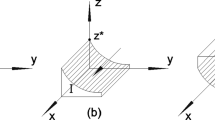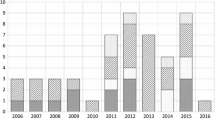Abstract
China is a country that suffers frequently from natural catastrophic events. Because of its limited resources, the government requires the assistance of nonprofit organizations (NPOs) in providing relief to affected communities. Previous studies on the government’s mobilization strategy following a disaster are surprisingly scarce, and the few existing studies typically neglected the differences between government-owned NPOs (GONPOs) and grassroots NPOs (GRNPOs). In the Chinese context, GONPOs rely on resources provided by the government and are amenable but have low initiative, while GRNPOs are highly enthusiastic but difficult to manage. This study identified the government’s discriminative strategy toward GONPOs and GRNPOs in coping with a disaster. Drawing on the evolutionary game theory, this study examined the interactive mechanism and factors in the relationship of the government with GONPOs and GRNPOs in disaster mobilization. Moreover, the optimal strategy is identified considering the cooperation benefit, reward incentive, punishment for nonfeasance, efficiency of response, cost of coordination, and value of legitimacy. Based on the results, this study provided practical implications both for the government and NPOs in disaster mobilization.





Similar content being viewed by others
References
Bajek R, Matsuda Y, Okada N (2008) Japan’s jishu-bosai-soshiki community activities: analysis of its role in participatory community disaster risk management. Nat Hazards 44(2):281–292
Benson C, Twigg J, Myers M (2001) Ngo initiatives in risk reduction: an overview. Disasters 25(3):199–215
Chen S, Luo Z, Pan X (2013) Natural disasters in china: 1900–2011. Nat Hazards 69(3):1597–1605
Cutter SL, Boruff BJ, Shirley WL (2003) Social vulnerability to environmental hazards. Soc Sci Quart 84(2):242–261
Eakin H, Luers AL (2006) Assessing the vulnerability of social-environmental systems. Annu Rev Environ Resour 31(1):365
Hou JD, Lv J (2013) Evolutionary gaming of cooperation between the government and the nonprofits in the chinese geo-disaster emergency management. Disaster Adv 6(4):48–58
Jiang JW, Tang MH (2011) Strategy research on public crisis in China: a case of natural hazard mobilization. Tian Fu Xin Lun 65(2):80–85
Kaiser R, Spiegel PB, Henderson AK, Gerber ML (2003) The application of geographic information systems and global positioning systems in humanitarian emergencies: lessons learned, programme implications and future research. Disasters 27(2):127–140
Keller MB, Lavori PW, Friedman B, Nielsen E, Endicott J, McDonald-Scott P, Andreasen NC (1987) The longitudinal interval follow-up evaluation: a comprehensive method for assessing outcome in prospective longitudinal studies. Arch Gen Psychiatry 44(6):540–548
Lu MG, Zhan JH (2010) Ngos participation in disaster relief and relevant management: case study of Wenchuan earthquake and Taiwan 9.21 earthquake. Public Adm J 31(6):98–103
Mandl D, Sohlberg R, Justice C, Ungar S, Ames T, Frye S, Chien S, Tran D, Cappelaere P, Sullivan D et al. (2008) A space-based sensor web for disaster management. In: Geoscience and Remote Sensing Symposium, 2008. IGARSS 2008. IEEE International, IEEE, vol 5, pp V–294
Mansor S, Shariah MA, Billa L, Setiawan I, Jabar F (2004) Spatial technology for natural risk management. Disaster Prev Manag 13(5):364–373
Mohanty M (2008) Role of ngos in management of natural disasters. Disaster Adv 1(1):15–17
Sakamoto M (2012) The rise of ngos/npos in emergency relief in the great east Japan earthquake. Jpn Soc Innov J 2(1):26–35
Salmon P, Stanton N, Jenkins D, Walker G (2011) Coordination during multi-agency emergency response: issues and solutions. Disaster Prev Manag 20(2):140–158
Simo G, Bies AL (2007) The role of nonprofits in disaster response: an expanded model of cross-sector collaboration. Public Adm Rev 67(s1):125–142
Teich JM, Wagner MM, Mackenzie CF, Schafer BGKO (2002) The informatics response in disaster, terrorism, and war. J Am Med Inform As 9(2):97–104
Tsukamoto I, Nishimura M (2006) The emergence of local non-profit-government partnerships and the role of intermediary organizations in Japan: contractual relationships and the limits to co-governance. Public Manag Rev 8(4):567–581
Xu JP, Zhang L (2013) A comparative study on the national counterpart aid model for post-disaster recovery and reconstruction: 2008 Wenchuan earthquake as a case. Disaster Pre Manag 22(1):75–93
Xue L, Tao P (2013) Research on social mobilization in the emergency administration system: from spontaneously unordered to orderly and coordinated-a case study of lushan earthquake relief work. Adm Reform 46(6):30–34
Yi YL, Lv L (2011) Research on interaction relation between government and nonprofit organizations in public management perspective. Manag J 7:1–13
Zhang YL (2008) Research on the innovation of social mobilization model in disaster relief activity. China Soc Period 33:21–22
Acknowledgments
This research was supported by the National Natural Science Foundation of China under Grants 71172094/G0216 and 71472070/G0216.
Author information
Authors and Affiliations
Corresponding author
Rights and permissions
About this article
Cite this article
Du, L., Qian, L. The government’s mobilization strategy following a disaster in the Chinese context: an evolutionary game theory analysis. Nat Hazards 80, 1411–1424 (2016). https://doi.org/10.1007/s11069-015-1843-2
Received:
Accepted:
Published:
Issue Date:
DOI: https://doi.org/10.1007/s11069-015-1843-2




